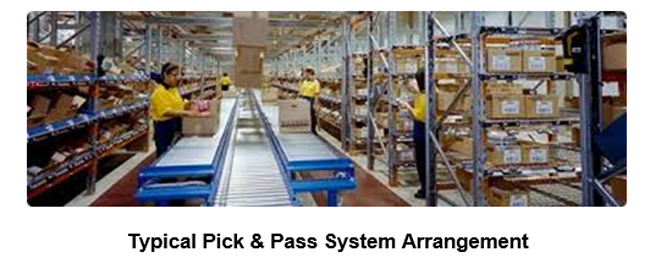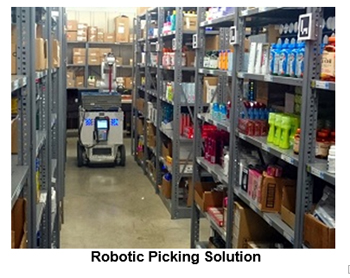Holste Says... |
 |
| As is true with all picking systems, flexibility is not only desirable it is essential to being able to adapt to changes in customer order profiles, SKU mix and sales volume. |
 |
What do you say? |
 |
| Click here to send us your comments |
|
|
|
While reporting from ProMat 2017, Dan Gilmore and I reviewed several automated piece picking technologies (see videos Day 1 and Day 2). Most (if not all) of these picking solutions are based on a serial pick and pass zone picking configuration. So the question is how can you determine the number of picking zones that will be needed? This is a very important consideration as the answer will determine how many pickers (robots or humans) are needed. Coming at it from a slightly different prospective, you might ask - are more zones better than too few? DC operations managers know that getting this right is critical to being able to balance picking and shipping operations and to obtaining high throughput levels. Having too many or too few zones, automated or not, either way order processing efficiency will take a hit.
In a logical thinking world one would say that you simply calculate the number of pickers required to satisfy demand and then create a zone for each one of them. But that logic ignores too many of the factors that make a serial zone picking system work well.
For starters, the number of pickers varies greatly during the year, month, week or even the day. And, the number of pickers surely will be smaller when the system is new, than when volumes reach planning goals. However, when zones are established and integrated into a conveyor system layout, they may not be easy to change.
Understanding the Process and Order Flow

Start by first look at a typical manual pick and pass system configuration (pictured above) where a powered takeaway conveyor line is centered between two banks of carton flow racks. Dead roller conveyor is located along both sides of the powered conveyor line leaving enough aisle space for picking between the face of the flow rack and the edge of the roller conveyor. All picking must begin in the first zone. A preprinted pick-list is attached to an empty container (tote box or shipping carton), and the container is placed on the roller conveyor. The picker working that zone pushes the container (sometimes 2 or 3 at a time) thru the zone, picking the required product (for each container) along the way. The picker is required to check off each product picked.
At the end of the zone the container is either complete (no more items required) or it requires items from downstream zones. If the container is complete, it is pushed onto the powered takeaway line where it is transported to order checking, packing, and shipping. If more items are required the container is passed onto the next downstream zone and the picking routine is repeated. The container is passed thru each consecutive zone until all items on the order have been picked. All orders start in the first zone even if no picks are required in that zone. If the order requires a pick in the first and last zones, it must be pushed thru all of the in-between zones. Because re-circulations cause an extra load for the system and can greatly reduce throughput capacity, it should be avoided.
In the above example, a paper pick-list is used to drive item picking. As an alternative, RF, Pick-to-Light, or Voice technologies are commonly used to drive the physical picking operation. While these picking methods have been proven to increase productivity and reduce errors, the flow of containers within the pick and pass system remains the same. The order containers need to be sent efficiently through the zone picking system to keep the cumulative workload of the zones equalized during the day.
In a simple pick-and-pass system with paper pick-list, it’s relatively easy to physically adjust zone size and number. With RF terminals or voice-directed systems, you can change the zone sizes a bit more dynamically. But with light-directed picking, zones may be fixed in size and number. So to some degree zone constraints will be a factor of the type of picking technology being considered.
 With a robotic picking solution most (if not all) of the above human facilitating equipment and technologies are eliminated. However, determining the optimum number of picking zones remains a key consideration. With a robotic picking solution most (if not all) of the above human facilitating equipment and technologies are eliminated. However, determining the optimum number of picking zones remains a key consideration.
No Simple Answer
If you are considering deploying a pick-and-pass zone picking system (automated or manual) the question of how many zones can best be addressed with a list of things to consider, such as:
- How will the system direct the pickers? Can the number of pick faces be increased or decreased? (Here you are looking for flexibility in zone configuration relative to SKU slotting)
- Can the system support more than one picker in a zone? On the same order or on different ones? (In this case you are looking for ability to handle peak volume periods)
- Can the zone boundaries be changed easily? Every once in a while, by wave or by order? (Is zone size dynamic or static?)
- Are the pickers picking one order at a time or a batch of several orders?
- Can zones overlap?
- How does the problem differ for serial zones with by-pass and/or zone skipping capability?
- Beyond the physical, look for on-demand control and software capability that allow for system configuration optimization strategies based on requirements.
If you are considering automated picking solutions, be sure to review replenishment requirements, peak volume handling capabilities, and the level of IT support needed to keep the system running.
Final Thoughts
As is true with all picking systems, flexibility is not only desirable it is essential to being able to adapt to changes in customer order profiles, SKU mix and sales volume. One must be able to change the physical profile of the picking face and re-slot product whenever necessary to obtain high throughput and productivity levels.
Any reaction to this Expert Insight column? Send below.
Your Comments/Feedback
|